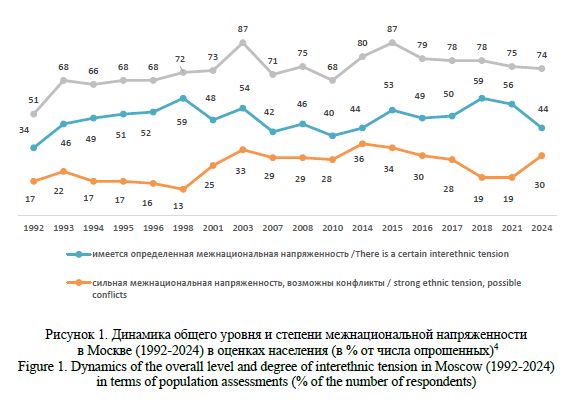Specifics of interethnic and ethno-confessional interaction of various religious groups of Moscow students
High levels of interethnic tension have persisted in the Moscow metropolitan area for more than a decade. As the high degree of national and religious tension leads to changes in the religious and sociocultural landscape, studying the issues of ethno-religious interaction is crucial for an accurate assessment of various areas of activity, especially in the context of the geopolitical turbulence that Russia has faced in recent years. The development of ethno-religious conflicts depends on many factors: political, socio-economic, and sociocultural transformations, mass unregulated migration, the propaganda ambivalence of media networks that use digital technologies, etc. Against this backdrop, the intolerant attitudes of the city's population inevitably grow. Sociological studies conducted at the Institute of Demographic Research of the Federal Research Center of the Russian Academy of Sciences examined the views of religious youth on phenomena in the field of interethnic and ethno-religious relations. It was revealed that the motives for the growth of religious youth groups and their appeal to confessions are based on the belief that traditional religions are the guardians of national, spiritual, moral, and cultural values. It is in these religions that young people seek protection from the infringement of their national rights, the loss of their national identity, and the risk of destruction of their cultural mentality. Thus, the focus of the sociological research is on studying the problem of ethno-confessional interaction and the degree of national and religious tolerance/intolerance among various religious groups (as exemplified by students) in the capital city. To determine the level of “ethno-confessional tolerance culture”, two typological groups were formed: “consecutive believers” and “new believers”. The formation of beliefs about national oppression and the humiliation of national dignity is associated with the growth of intolerant ethno-religious interaction, which can be observed in all aspects of the analysis of the group of “new believers”. The verbal orientation towards active conflict actions is more characteristic of the group of “new believers”, whereas the group of “convinced believers” has a smaller “conflict charge”, and is more tolerant and tolerant of other nationalities. As for inter-religious relations, both groups of believers, for the most part, are neutral and tolerant towards representatives of other religions. Thus, the results of this study confirm previous monitoring studies that the sources of tension in the field of ethno-religious interaction are primarily related to interethnic relations, and the level of religious intolerance does not generally lead to an increase in conflict potential in the religious sphere.
Figures

.







Kublitskaya, E. A. (2025), “Specifics of interethnic and ethno-confessional interaction of various religious groups of Moscow students”, Research Result. Sociology and management, 11 (3), 18-43. DOI: 10.18413/2408-9338-2025-11-3-0-2.


















While nobody left any comments to this publication.
You can be first.
Volodenkov, S. V., Fedorchenko, S. N., Pechenkin N. M. (2023), “Influence of the Digital Environment on the Contemporary Worldview: Pro et Contra”, RUDN Journal of Political Science, 25(1), 113-133, DOI: 10.22363/2313-1438-2023-25-1-113-133, EDN: QWTETU. (In Russian)
Grazhdanskaya, etnicheskaya i regionalnaya identichnost: vchera, segodnya, zavtra [Civic, ethnic and regional identity: yesterday, today, tomorrow] (2013), hands. project and resp. ed. L. M. Drobizheva, Russian Political Encyclopedia, Moscow, Russia, ISBN 978-5-8243-1772-5, EDN: RVDLPH. (In Russian)
Dagbaeva, S. B. (2012), “Ethnic socialization of the younger generation in a changing world”, Humanitarian vector, 1(29). 240-246. (In Russian)
Drobizheva, L. M. (2011), “Russian identity and tolerance of interethnic relations: the experience of 20 years of reforms”, Bulletin of the Kennan Institute in Russia, (20), 22-32, EDN: OWKQQB. (In Russian)
Dmitrieva, A. V. (2010), “De-escalation of conflicts as a way to stabilize regional societies”, Sotsialnye faktory konsolidatsii rossiyskogo obshhestva: sotsiologicheskoe izmerenie, New chronograph, Moscow, Russia, 200-221, ISBN 978-5-94881-112-3, EDN: VZOOCN. (In Russian)
Dzyaloshinsky, I. M. (2012), “The role of the media in shaping the image of the “Other”, Media. Informatsiya. Kommunikatsiya, (1), 1-19, EDN: TGOKAZ. (In Russian)
Kargina, I. G. (2017), “Complication of the nature and field of religious conflicts associated with religion as a manifestation of a normal anomia”, «Normalnaya anomiya» v Rossii i sovremennom mire: kollektivnaya monografiya [“Normal Anomie” in Russia and the Modern World: A Collective Monograph], ed. by S. A., Kravchenko, MGIMO-University, Moscow, Russia, 220-255, ISBN 978-5-9228-1750-9. (In Russian)
Kublitskaya, E. A. (2009), “The problem of tolerance in interethnic and ethno-confessional relations (the experience of sociological research in the metropolitan metropolis)”, Gosudarstvo, religiya, Tserkov v Rossii i za rubezhom, 27 (4). 97-104, EDN: MQJBZL. (In Russian)
Kublitskaya, E. A. (2013), “Conflict potential of interethnic and ethno-confessional relations”, Rossiya i musulmansky mir, 9 (255), 35-43, EDN: RCSHKZ. (In Russian)
Kublitskaya, E. A. (2015), “The nature of interethnic and ethno-confessional interaction in multi-ethnic regions of the Russian Federation”, Pravoslavie i sovremennost: problemy sekulyarizma i postsekulyarizma [Orthodoxy and modernity: problems of secularism and post-secularism], Eagle, Moscow; Publishing House of the Novospassky Monastery NP Spasskoye Delo Livny, Russia, 83-124, ISBN: 978-5-9906510-0-5. (In Russian)
Kublitskaya, E. A. (2020), “The problem of tolerance in ethno-confessional interaction (on the example of monitoring the metropolitan metropolis)”, «Alma mater (Vestnik vysshey shkoly)», (11), 54-59, DOI: 10.20339/AM.11-20.054. (In Russian)
Levy-Stros, K. (2015), Strukturnaya antropologiya [Structural anthropology], Science, Moscow, Russia. (In Russian)
Parsons, T. (2002), O strukture sotsialnogo deistviya [On the structure of social action], Academic Project, Moscow, Russia, ISBN: 5-8291-0237-4. (In Russian)
Smelzer, N. (1994), Sotsiologiya [Sociology], ed. By V. A. Yadova, Phoenix, Moscow, Russia, ISBN 5-7113-0106-3. (In Russian)
Fenomen etnicheskogo konflikta: mezhdistsiplinarny podkhod i obshhestvennye praktiki. Opyt preduprezhdeniya i uregulirovaniya konfliktov [Ethnic conflict phenomenon: interdisciplinary approach and community practices. Experience in Conflict Prevention and Resolution] (2018), ed. by Tishkov V. A., Stepanov V. V., IEA RAS, Moscow, Russia, ISBN: 978-5-4211-0232-8. (In Russian)
Habermas, Y. (2006), “When should we be tolerant? On the competition of visions of the world, values and theories”, Socis, (1), 47, ISSN: 0132-1625. (In Russian)
Chelysheva, I. (2020), Razvitie mezhetnicheskoy tolerantnosti studencheskoy molodezhi sredstvami mediaobrazovaniya: opyt prakticheskoy realizatsii [The development of interethnic tolerance of students by means of media education: experience of practical implementation], OD “Information for all”, Moscow, Russia, EDN: EPEMJP. (In Russian)
Adisa, R. M., Segbefia, S. K., Mohammed, S., Trofimova, G. N. (2024), “Misinformation and Disinformation in Ethno-Religious Conflicts: A Comparative Study of Media in Ghana and Nigeria. RUDN”, Journal of Studies in Literature and Journalism, 29 (2), 346-357, DOI: 10.22363/2312-9220-2024-29-2-346-357 journals.rudn.ru+1.
Bisallah, H. (2024), “Analysis of the Effects of Ethno-Religious Conflict on Educational Development in Zangon Kataf”, Kaduna State, DOI: 10.13140/RG.2.2.20430.88641.
Evstigneev, V., Voronin, D., Yarmak, O., Bolshakova, M. (2022), “Factor model of expectations of inter-ethnic and inter-religious conflicts among Russian students”, Transportation Research Procedia, (63), 367-376, DOI: 10.1016/j.trpro. 2022.06.024, EDN: QMGHPJ.
Gorrell, G., Bakir, M. E. (2019), “Race and Religion in Online Abuse towards UK Politicians”, Working Paper, [Online], available at: https://www.researchgate.net/publication/336230246_Race_and_Religion_in_Online_Abuse_towards_UK_Politicians_Working_Paper (Accessed 25 August 2025).
Kanas, A., Scheepers, P., Sterkens, C. (2022), “Ethno-Religious Identification and Support for Inter-Religious Violence: A Study of Muslim and Christian Students in Indonesia and the Philippines”, Politics and Religion, 15 (2), DOI: 10.1017/S1755048321000146.
Kešeljević, A., Nikolic, S., Spruk, R. (2025), Ethnic Conflicts, Civil War and Economic Growth: Region-Level Evidence from former Yugoslavia, 60, DOI: 10.48550/arXiv.2505.02431.
Koenig, M. (2023), “Religious Diversity, Islam, and Integration in Western Europe - Dissecting Symbolic, Social, and Institutional Boundary Dynamics”, KZfSS Kölner Zeitschrift für Soziologie und Sozialpsychologie, (75), 1-27, DOI: 10.1007/s11577-023-00911-5.
Michon, B. (2019), “French and German teenagers in multicultural cities: Religious indifference as a paradox of secular societies”, Social Compas, 66 (1), 94-111, DOI: 10.1177/0037768618815779.
Palard, Y. (2020), “Negotiating Religious Otherness: Islam, Catholicism and Secularism in France”, Archives de Sciences Sociales des Religions, 192, DOI:10.4000/assr.58844.
Santagati, M. (2020), “Religious Conflicts in Multicultural Schools: A Generational Divide between Students and Adults”, In Migrants and Religion: Paths, Issues, and Lenses, Brill, 715-753, DOI: 10.1163/9789004429604_024.
Sokol, L., Kalemaj, I. (2020), ““Sources and Continuities of Ethno-Religious Nationalism in the Western Balkans”. Nomos. Southeast European Integration Perspective”, The Challenges of Democratization and Reconciliation in the Post-Yugoslav Space, (13), 153-168.